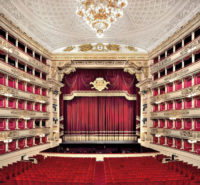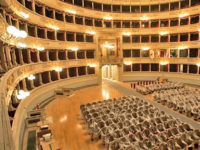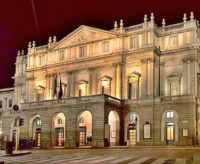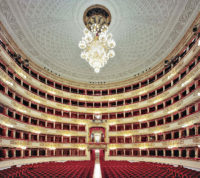The building with severe lines stands on one side of the Piazza della Scala. In the center of the square is the monument to Leonardo da Vinci by the sculptor Pietro Magni (1872). Around the base, under the statue of Leonardo are four of his followers, Cesare da Sesto, Andrea Solari, Giovanni Antonio Boltraffio, and Marco d’Oggiono The witty Milanese have nicknamed the monument “on liter in quater”. It seems that they see a litre (about a quart) bottle of wine (Leonardo) and all around below four clients ready to serve themselves.
The Teatro alia Scala is, for the Milanese and many others, simply “La Scala” Of all the marvelous things that one can see in this city, the reason why tens of thousands of people come to Milan is to go to this opera house.
Where did it get its name? Giuseppe Piermarini started construction in 1776 on the site of the former church. Santa Maria della Scala. The wife of Bernabo Visconti, Beatrice Regina della Scala had it built in the 14th century. The theatre was opened on August 3, 1778 with the opera, “Europa Riconosciuta” by Antonio Salieri. During the last two centuries it has hosted first nights of works by Rossini, Verdi, Bellini, Donizetti, Ponchielli, Boito, Puccini, and Mascaqni and has become a veritable sanctuary for opera lovers.
Devastated by bombings during the last war and faithfully reconstructed as it formerly was, the theatre was reopened in 1946 with “La Gazza Ladra” by Rossini and conducted by Arturo Toscanini.
The Museo Teatrale alia Scala, in the same building but independent of the Theatre, exhibits an important and very interesting collection of paintings and objects illustrating the history of every variety of show business.
The Piccola Scala, built in 1955 on the side of the building on Via Filodrammatici offers a repertoire of 17th and 18th century works as well as contemporary theatre. La Scala is an autonomous institution whose aim is to make music – and the study of music available to all through the presentation of concerts, opera and ballet. On this basis, those who have guided and directed the theatre in recent years have gradually reduced the aristocratic elements which make it up in order to create a great musical theatre that is accessible to the man on the street.




























